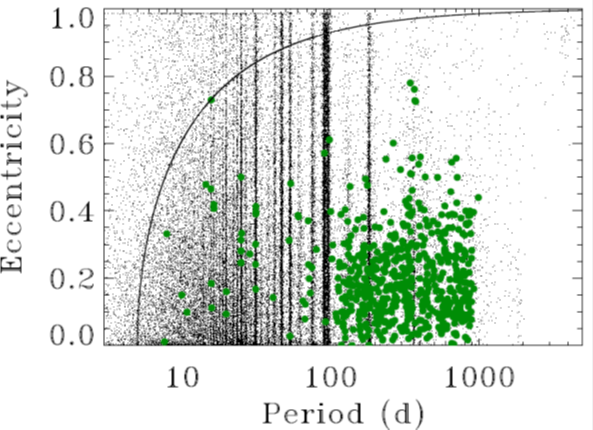7.3.5 Quality assessment and validation
Verification

The candidates were visually inspected in aggregated one- and two-dimensional diagrams such as astrometric residual and orbital-model plots, as well as placement in the observational Hertzsprung–Russell diagram and agreement with derived astrophysical parameters. As an example, Figure 7.22 shows the - diagram of a representative subset of orbits obtained for the stochastic solution sample, compared to the distribution in eccentricity and period of the OrbitalAlternative sample selected using the acceptance criteria listed in Section 7.3.4. See Holl et al. (2023b) for additional details.
One issue which was found too late in the verification process is that the astrometric_n_good_obs_al erroneously reports the same value as astrometric_n_obs_al, the number of CCD observations that were available before outlier rejection.
Validation
Validation included comparison with publicly-available astrometry and radial velocity (RV) data from the literature, Gaia radial velocity solutions, comparison with other Gaia DR3 non-single star solutions for the same source.
For a given Gaia DR3 solution the validation step resulted in one of the following three outcomes: (a) If the solution was found to be in general agreement with a validation solution, the solution type was appended with the “Validated” suffix. (b) If the solution passed all validation checks but could not be validated with independent data, the solution was published with the nominal solution type name. (c) If a solution was found to be incompatible with validation data, typically these were RV data, it was removed and consequently not published.
Based on the outcome of the validation procedure, no OrbitalAlternative solutions were removed, while the sample of OrbitalTargetedSearch solutions eventually published is 533. About one-third of the sources with a solution of type “OrbitalTargetedSearch[Validated]” also has an additional solution in the nss_two_body_orbit table, predominantly of type “AstroSpectroSB1” or “SB1”. Please see Holl et al. (2023b) for a more detailed discussion on the validation and its results.